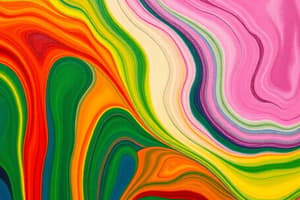Podcast
Questions and Answers
What is the primary advantage of using synthetic rubbers like SBR in tire manufacturing?
What is the primary advantage of using synthetic rubbers like SBR in tire manufacturing?
- They are biodegradable.
- They are not suitable for high-temperature applications.
- They can be stretched and return to original shape. (correct)
- They have lower cost than natural rubber.
Which material is primarily used for making laminated glass?
Which material is primarily used for making laminated glass?
- Wood sheets
- Asbestos fiber
- Plastic sheeting
- Polyvinyl-butyl resin (correct)
Which of the following products is typically made from laminated plastics?
Which of the following products is typically made from laminated plastics?
- Wall paneling (correct)
- Carpets
- Tyres
- Clothes
Who developed the method of vulcanization of rubber?
Who developed the method of vulcanization of rubber?
What are the primary components used to create laminated materials?
What are the primary components used to create laminated materials?
Which type of polymer is recognized for its ability to conduct electricity?
Which type of polymer is recognized for its ability to conduct electricity?
Which type of polyethylene is produced using high pressure methods?
Which type of polyethylene is produced using high pressure methods?
What property allows silicone-based materials to be suitable for high temperature applications?
What property allows silicone-based materials to be suitable for high temperature applications?
What catalyst is used in the polymerization process of polypropylene?
What catalyst is used in the polymerization process of polypropylene?
What is a key characteristic of PVC?
What is a key characteristic of PVC?
What is the main use of blended conducting polymers?
What is the main use of blended conducting polymers?
Which applications are associated with polytetrafluoroethylene (TEFLON)?
Which applications are associated with polytetrafluoroethylene (TEFLON)?
What characteristic of plywood contributes to its strength?
What characteristic of plywood contributes to its strength?
The major constituents of adhesives in paint industry often include which thermosetting polymer?
The major constituents of adhesives in paint industry often include which thermosetting polymer?
What is terylene better known as?
What is terylene better known as?
What is a typical use of polyurethanes?
What is a typical use of polyurethanes?
Flashcards are hidden until you start studying
Study Notes
Vulcanization of Rubber
- In 1839, Charles Goodyear discovered vulcanization, a process that significantly improves the properties of natural rubber.
Important Thermoplastics
- Polyethylene: Polymerised ethylene, a colorless gas produced by dehydrating ethyl alcohol at 160°C with concentrated H2SO4.
- LDPE (Low-density polyethylene): Produced using high-pressure methods (1050-2000 kgf/cm2) with free radical initiators.
- HDPE (High-density polyethylene): Produced using low-pressure methods (31 kgf/cm2) with ionic catalysts.
- Polypropylene: Obtained by polymerizing propylene in the presence of Ziegler-Natta Catalyst. Applications include packaging for pharmaceuticals and cosmetics, sterilizable hospital equipment, washing machine parts, pipes, TVs, radios, molded luggage, and colorful furniture.
- Polyvinyl Chloride (PVC): The most widely used plastic, made by polymerizing vinyl chloride, which is produced by directly adding HCl to acetylene at 60°C-80°C. Known for its high rigidity and chemical resistance, but brittle. Used in cables, water hoses, raincoats, petroleum industry pipes.
- Polytetrafluoroethylene (TEFLON): Obtained by polymerizing a water-emulsion of tetrafluoroethylene under pressure and in the presence of benzoyl peroxide as a catalyst. Used in non-stick cookware coatings, gaskets, pump parts, tank linings, non-lubricating bearings, and non-reactive coatings.
- Polyurethanes: A varied range of crosslinked polymers created from two liquids - a polyol and an isocyanate. Used as insulating material in refrigerators, pillows, mattresses due to its spongy nature.
Important Thermosetting
- Epoxy Resin: Obtained from the polycondensation of epichlorohydrin with polyphenols or polyalcohols. Used as the major constituent of adhesives in the paint industry and as an insulator in the electrical industry.
- Polyester: Terylene (British name for Dacron) is produced by condensing ethylene glycol and terephthalic acid. Primarily used in synthetic fibers for garments and can be blended with wool for carpets, blankets, upholsteries, and quilts.
- Silicones: Contain alternating silicon-oxygen bonds with organic radicals attached to silicon atoms. Used in cosmetics for damping, silicone-glass laminates for high-temperature applications.
Synthetic Rubbers
- Artificially produced rubber-like polymers capable of stretching to at least twice their length and returning to their original shape and size after stress release.
- SBR (Styrene Butadiene Rubber): Similar in processing and finished product characteristics to natural rubber. Mainly used in tire manufacture and also in shoe soles, other shoe components, wire and cable insulation, adhesives, and vessel linings.
MISCELLANEOUS POLYMERS
- Laminate: Formed by joining two or more layers of solid materials using an adhesive.
- Plywood: Consists of odd numbers of wood layers (0.5-10 mm thick) bonded with the grain of alternate layers at right angles (cross-laminate). Applications include railway coaches, cabinets, false ceilings, and other house building purposes.
- Laminated Plastics: Paper, cloth, asbestos fiber, glass, metal, etc., are impregnated with thermosetting resins like phenol-formaldehyde or urea-formaldehyde solutions in solvent. Used in electrical and insulating materials, pump parts, and decorative purposes on table tops and wall panelings.
- Laminated Glasses: Two glass sheets are joined by a plastic sheet in between. Polyvinyl-butyl resin can be used for transparency. Bullet-proof or splinter-proof laminated glass is obtained by curing the laminates in an oven under heat and pressure.
Conducting Polymers
- Made from special powders, categorized as:
- Pi-electrons conducting polymer
- Conducting element-filled polymer
- Inorganic polymer
- Doped-conducting polymer
- Blended conducting polymer
- Used in:
- Button cells
- Photovoltaic devices
- Sensors
- Biomedical devices
Studying That Suits You
Use AI to generate personalized quizzes and flashcards to suit your learning preferences.



